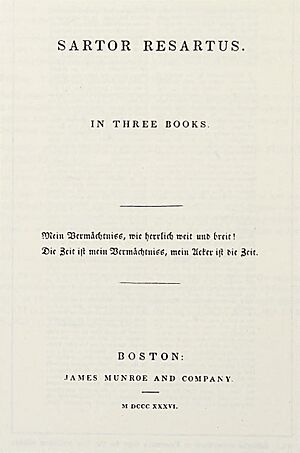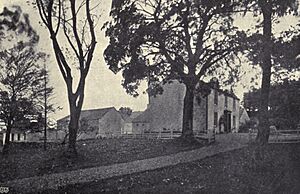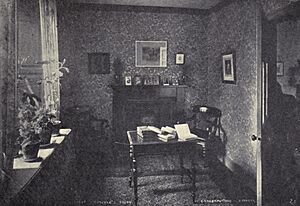Sartor Resartus facts for kids

Title page of the first American edition (1836)
|
|
| Author | Thomas Carlyle |
|---|---|
| Country | Great Britain |
| Language | English |
| Genre | Comic novel, sui generis |
| Publisher | Fraser's Magazine |
|
Publication date
|
1833–1834 |
Sartor Resartus is a unique book written by the Scottish writer Thomas Carlyle. It was first published in parts in Fraser's Magazine between 1833 and 1834. The book pretends to be a review of a made-up German philosopher's ideas. This philosopher is named Diogenes Teufelsdröckh, which means 'God-born Devil's-dung'. He wrote a book called Clothes: Their Origin and Influence.
An English "Editor" (who is also a character) talks about Teufelsdröckh's deep thoughts. The Editor is a bit unsure about these ideas. He also shares bits and pieces of the philosopher's life story. This work is partly a funny imitation of other German philosophical ideas.
Contents
How the Book Was Made
Experts believe Sartor Resartus was inspired by three main books. The first was A Tale of a Tub by Jonathan Swift. Carlyle really admired Swift when he was younger. In Swift's book, three Christian traditions are shown as brothers. Their father gives them clothes they should never change. But they change them anyway to follow fashion.
Carlyle also translated works by Johann Wolfgang von Goethe. These included Wilhelm Meister's Apprenticeship and The Sorrows of Young Werther. Carlyle mentions these books in Sartor Resartus. For example, Teufelsdröckh calls his own tough time "The Sorrows of Young Teufelsdröckh". The third big influence was Tristram Shandy. Carlyle used many phrases from this book.

Carlyle worked on an earlier novel called Wotton Reinfred. Some people call it the first draft of Sartor. Carlyle wrote seven chapters of this story. It was about a young man who grew up very religious. He faced heartbreak and then wandered around. He found comfort in a mysterious stranger named Maurice Herbert. This stranger invited Wotton into his home. They often talked about deep philosophical ideas.
Even though Carlyle's wife, Jane Carlyle, liked Wotton Reinfred, Carlyle never published it. Many parts of Wotton were later used in Sartor Resartus. Carlyle changed them into funny stories about Teufelsdröckh's life. The Editor in Sartor often complains that these stories are too broken up.
Carlyle had trouble finding someone to publish Sartor Resartus. He started writing it as an article in October 1831. This was at Craigenputtock, his home. Fraser's Magazine published it in parts from 1833 to 1834. The full book first came out in Boston, USA, in 1836. Ralph Waldo Emerson, an American writer, helped arrange this. Emerson admired the book and Carlyle very much. Thanks to Emerson, Carlyle got good payment for the book in America. It didn't earn as much in Britain at first. The first British edition was published in London in 1838.
What the Title Means
The title "Sartor Resartus" is usually translated as "The Tailor Re-tailored". It can also mean "The Tailor Repatched" or "The Tailor Made Whole Again".
There was a song called "The Taylor Done Over" published in 1785. Some think a Scottish version of this song might have inspired Carlyle's title. Another idea is Lord Byron's play The Deformed Transformed (1824). This play was based on Goethe's Faust. Goethe liked Byron's play, and Goethe was a friend and mentor to Carlyle.
What Happens in the Story
The book is written like a long review by an unnamed Editor. This Editor works for an English magazine. He is reviewing a made-up German book called Clothes, Their Origin and Influence. This book was written by a made-up philosopher named Diogenes Teufelsdröckh. Teufelsdröckh is a professor of "Things in General" at Weissnichtwo University. Weissnichtwo means "Know not where".
The Editor is clearly confused by Teufelsdröckh's book. He tries to explain it using current problems in England. He knows Germany has similar problems. The Editor then admits he knows Teufelsdröckh personally. But even this doesn't help him understand the book's strange ideas. The Editor says he asked Teufelsdröckh's office for more information about his life. He hoped this would help explain things.
The first part of the book summarizes Teufelsdröckh's ideas. It includes translated quotes from his book. The Editor adds many of his own thoughts and disagreements. He often uses quotes from Goethe and Shakespeare. The review gets longer because the Editor is frustrated. He wants to show how wild these ideas are. At the end of the first part, the Editor gets a reply from Teufelsdröckh's office. It's several bags of paper scraps. These scraps are organized strangely, like the signs of the Latin Zodiac. They contain bits of Teufelsdröckh's life story.
In the second part, the Editor tries to put these scraps into a clear story. As a boy, Teufelsdröckh was left in a basket. A couple in the German town of Entepfuhl ("Duck-Pond") found him. His father was a retired soldier. His mother was a very religious woman. Teufelsdröckh was thankful she raised him with strong spiritual rules. Teufelsdröckh remembers his happy childhood in great detail. The Editor notes that his descriptions come from a lot of spiritual pride.
Teufelsdröckh is seen as smart and sent to Hinterschlag (slap-behind) Gymnasium. There, he learns a lot and makes friends with some teachers. But other students often bully him. He has mixed feelings about this time. He is glad for his education. But he criticizes how it ignored real human actions and character. This applies to how he was treated and how education relates to politics.
At University, Teufelsdröckh faces similar problems. But he eventually gets a small teaching job. He also gains some favor from German noble families. While with these groups, Teufelsdröckh meets a woman he calls Blumine. This means "Goddess of Flowers". The Editor thinks this is a made-up name. Teufelsdröckh leaves his teaching job to be with her. But she chooses to marry a British nobleman named Towgood instead.
This causes Teufelsdröckh a big emotional crisis. He leaves the city and travels around Europe. But even there, he sees Blumine and Towgood on their honeymoon. He falls into a deep sadness. This leads to what is called the "Everlasting No". In this state, he feels negative about all human activity.
The Editor is still trying to piece together the paper scraps. He thinks Teufelsdröckh might have fought in a war during this time. Or at least he uses a lot of war images. This leads him to a "Centre of Indifference". Thinking about old villages and history, he finally reaches "The Everlasting Yea". This is an acceptance of all life. The Editor is relieved. He promises to go back to Teufelsdröckh's book. He hopes his new understanding of Teufelsdröckh's life will help him understand the philosophy better.
Main Characters
- Herr Diogenes Teufelsdröckh: His name means "God-Born Devil-Dung" in Greek and German. He is the Professor of "Things in General" at Weissnichtwo University. He wrote a long book of German philosophy called Clothes, Their Origin and Influence. This book is what the novel is reviewing. Both the professor and his book are made up.
- The Editor: He is the person telling the story. As he reviews Teufelsdröckh's book, he shows a lot about his own opinions. He also feels sympathy for Teufelsdröckh. He worries a lot about the social problems of his time. His way of speaking changes. Sometimes he's chatty, sometimes he's critical, and sometimes he sounds like a prophet. The Editor is not Carlyle himself. Many parts of Teufelsdröckh's life are based on Carlyle's own experiences.
- Hofrath Heuschrecke: His name means "State-Councillor Grasshopper". He is a bit scattered and blindly admires Teufelsdröckh. He is the only one who advises the Editor and encourages him. He is often timid and feels cold. He represents many state-councillors of that time.
- Blumine: This woman is connected to German noble families. Teufelsdröckh falls in love with her early in his career. She chooses to marry Towgood instead of him. This leads Teufelsdröckh to his big emotional crisis, the "Everlasting No". Her name means "Goddess of Flowers". This might be a made-up name. Her story is a bit like Werther's unrequited love in The Sorrows of Young Werther. Some experts think Blumine is based on Kitty Kirkpatrick. Carlyle himself fell in love with her before marrying Jane Carlyle.
- Towgood: He is the English nobleman who marries Blumine. This causes Teufelsdröckh's emotional crisis. If Blumine is based on Kitty Kirkpatrick, then Towgood might be based on Captain James Winslowe Phillipps. He married Kirkpatrick in 1829.
Places in the Story
- Dumdrudge: This is a made-up village. The people there work hard and don't complain. It's like villagers everywhere who are content with their lives.
- Weissnichtwo: In the book, Weissnichtwo (which means "don't-know-where" in German) is a made-up European city. It's seen as the center of all good and bad influences of the time. The city is described in ways that fit city life in the early 1800s. The spiritual forces in society were so widespread then that it was hard to say where they were or weren't. That's why the city is called "Don't-know-where".
Main Ideas
Sartor Resartus was meant to be a new kind of book. It was both real and made-up, serious and funny, thoughtful and historical. It even made jokes about its own structure. It made readers think about where to find "truth." The book uses ideas from Tristram Shandy, which it mentions.
The made-up "Philosophy of Clothes" suggests that meaning comes from things we see and experience. These meanings are always changing. Cultures rebuild themselves with new fashions, power structures, and belief systems. The book talks about a strong idea of changing one's beliefs. This change isn't just about accepting God. It's about having the power to reject bad things and create meaning. Because of this, some writers see Sartor Resartus as an early existentialist book. This means it explores ideas about human freedom and finding meaning in life.
One of the funny parts of the book is Carlyle giving silly German names to places and people. For example, Teufelsdröckh's publisher is named Stillschweigen and Co. This means "Silence and Company." His home is in Weissnichtwo, meaning "Know-not-where." Teufelsdröckh's father believes that "there is much, nay almost all in Names."


